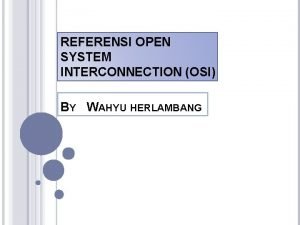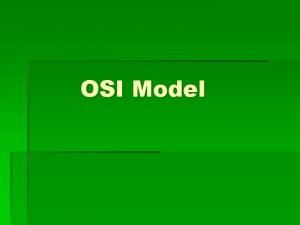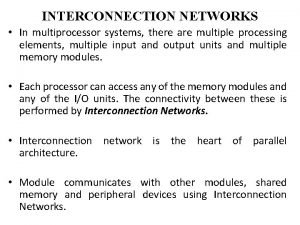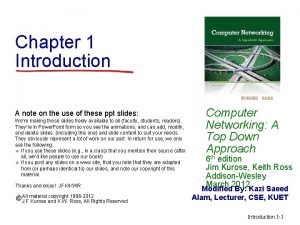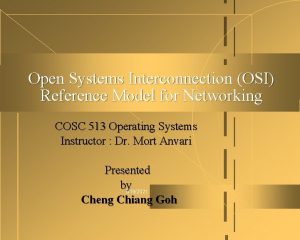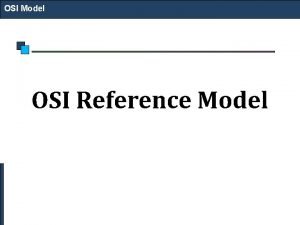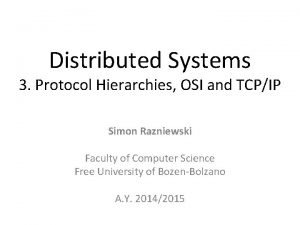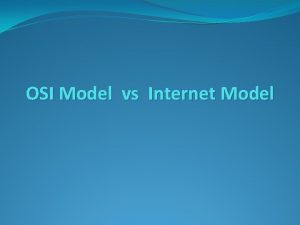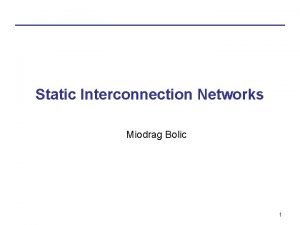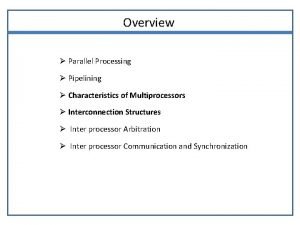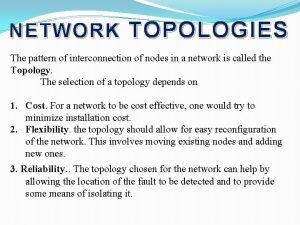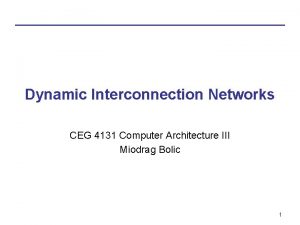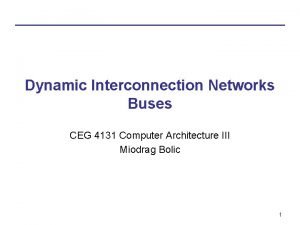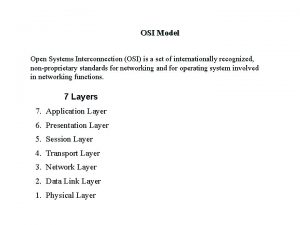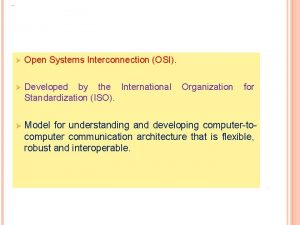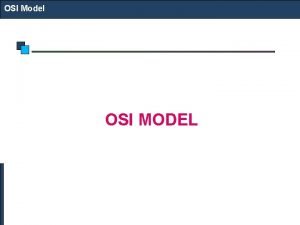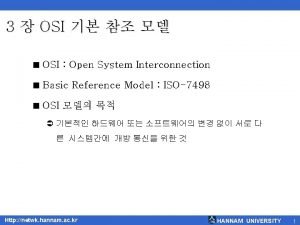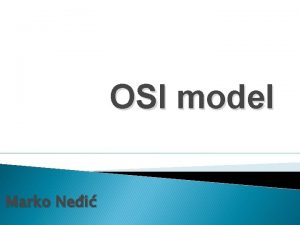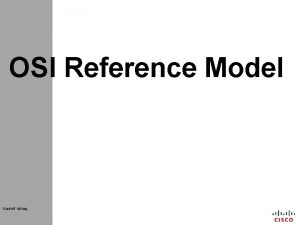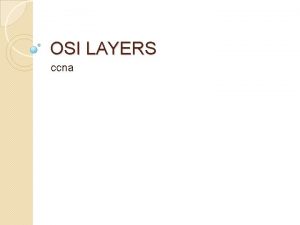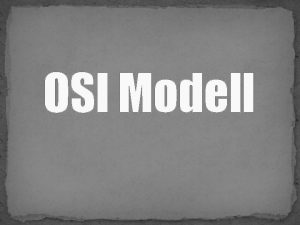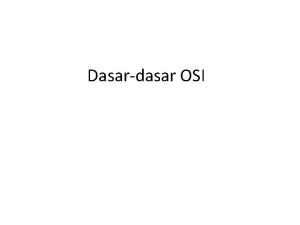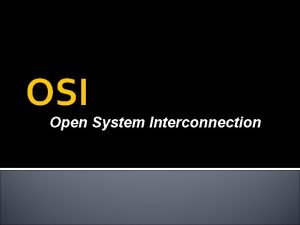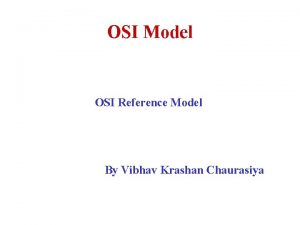THE OSI REFERENCE MODEL Open Systems Interconnection Reference


















- Slides: 18

THE OSI REFERENCE MODEL Open Systems Interconnection Reference Model

Agenda § Define OSI Model § Explain why it is important § Review each of 7 levels § Definition § Examples § OSI Packaging § Review

The OSI Model Definition Open Systems Interconnection (OSI) Reference Model is a set of internationally recognized non-proprietary standards for networking and for operating systems involved in networking functions. § Internationally recognized: Established by the International Organization of Standardization § Non-proprietary: Public domain. Can be freely used by any vendor. § The OSI model is a layered model that describes how information moves from an application program running on one networked computer to an application program running on another networked computer.

OSI Model Definition – 7 Layers § Layer 1 – Physical § Please § Layer 2 – Data Link § Do § Layer 3 – Network § Not § Layer 4 – Transport § Throw § Layer 5 – Session § Sausage § Layer 6 – Presentation § Pizza § Layer 7 - Application § Away

Why is the OSI model important? § To the computer industry: § § § Change Design Troubleshooting Training and education Interoperability between vendors § To you: § Help with troubleshooting network problems § Will be on certification exams § MCP § CCNA § Will be asked in an interview

An Analogy Application Presentation Session Transport Network Data Link Physical

The 7 Layers of the OSI Model

Layer 7 - Application The Application layer provides services to the software through which the user requests network services. § Examples: § § Internet Explorer, Safari, and other browsers FTP Mail Many applications that run on your computer are NOT part of the Application layer. This means that the following are not part of layer 7 because they do not request network services: § § Microsoft Word or Excel Adobe Photoshop Physical – Data Link – Network – Transport – Session – Presentation - Application

Layer 6 - Presentation Manages data-format information for networked communications (the network’s translator) § For outgoing messages, it converts data into a generic format for network transmission; for incoming messages, it converts data from the generic network format to a format the receiving application can understand § This layer is also responsible for certain protocol conversions, data encryption/decryption, or data compression/decompression § Examples: § § § MIDI JPG, GIF, TIF MPEG Physical – Data Link – Network – Transport – Session – Presentation - Application

Layer 5 - Session The Session layer establishes, maintains, and manages the communication session between computers. § Responsible for initiating, maintaining and terminating sessions § Responsible for security and access control to session information (via session participant identification) § Responsible for synchronization services, and for checkpoint services § Examples: § § § NFS SQL RPC Physical – Data Link – Network – Transport – Session – Presentation - Application

Layer 4 - Transport The functions defined in this layer provide for the reliable transmission of data segments, as well as the disassembly and assembly of the data before and after transmission. § Manages the transmission of data across a network § Manages the flow (flow control) of data between parties by segmenting long data streams into smaller data chunks (based on allowed “packet” size for a given transmission medium) (packet sequencing) § Provides acknowledgements of successful transmissions and requests retransmission for packets which arrive with errors (error detection and recovery) § Examples: § § TCP UDP Physical – Data Link – Network – Transport – Session – Presentation - Application

Layer 3 - Network The Network layer defines the processes used to route data across the network and the structure and use of logical addressing. § Handles addressing messages for delivery, as well as translating logical network addresses and names into their physical counterparts (Logical Addresses are managed by local network admins. ) § Responsible for deciding how to route transmissions between computers § This layer also handles the decisions needed to get data from one point to the next point along a network path § This layer also handles packet switching and network congestion control § Example: § § IP Network routers Physical – Data Link – Network – Transport – Session – Presentation - Application

Layer 2 – Data Link Concerned with the linkages and mechanisms used to move data about the network and deals with the ways in which data is reliably transmitted. § Handles special data frames (packets) between the Network layer and the Physical layer § At the sending end this layer handles conversion of data into raw formats that can be handled by the Physical Layer. At the receiving end, this layer packages raw data from the physical layer into data frames for delivery to the Network layer § The data link layer is often conceptually divided into two sub-layers: logical link control (LLC) and media access control (MAC). § Examples: § § § Network bridges Ethernet Wi-Fi Physical – Data Link – Network – Transport – Session – Presentation - Application

Layer 1 - Physical This layer defines the electrical and physical specifications for the networking media that carry the data bits across a network. § Converts bits into electronic signals for outgoing messages. Converts electronic signals into bits for incoming messages. (Performs bit synchronization. ) § This layer manages the interface between the computer and the network medium (coax, twisted pair, etc. ) § This layer tells the driver software for the MAU (media attachment unit) (eg. network interface cards (NICs), modems) what needs to be sent across the medium § Examples: § § Network hubs and repeaters LAN and WAN topology Physical – Data Link – Network – Transport – Session – Presentation - Application

The 7 Layers of the OSI Model

Summing up § What is the ISO Model? § Why is it important? § What are the 7 layers? Questions? § Homework § Review the definitions and examples of each layer § Take the test § Repeat as necessary

Additional Resources § http: //georgech. com/osi-model/ § § § Presentation and class notes Homework Links for additional information and reference Glossary of terms Class forum § George Chmielecki § george. chmielecki@verizon. net

Class dismissed!
 Osi modle
Osi modle Model open system interconnection
Model open system interconnection Open system interconnection
Open system interconnection Interconnection networks in multiprocessor systems
Interconnection networks in multiprocessor systems Responsibility of presentation layer
Responsibility of presentation layer Osi reference model ppt
Osi reference model ppt Disadvantages of osi reference model
Disadvantages of osi reference model Osi reference model diagram
Osi reference model diagram Osi model
Osi model Why and when osi reference model was invented?
Why and when osi reference model was invented? 영국 beis
영국 beis Osi model vs internet model
Osi model vs internet model Static interconnection network
Static interconnection network Static interconnection network in computer architecture
Static interconnection network in computer architecture Interconnection structure of multiprocessor
Interconnection structure of multiprocessor Advantages of bus network
Advantages of bus network The computer system and its interconnection structures
The computer system and its interconnection structures Dynamic interconnection network in computer architecture
Dynamic interconnection network in computer architecture Dynamic interconnection network in computer architecture
Dynamic interconnection network in computer architecture

